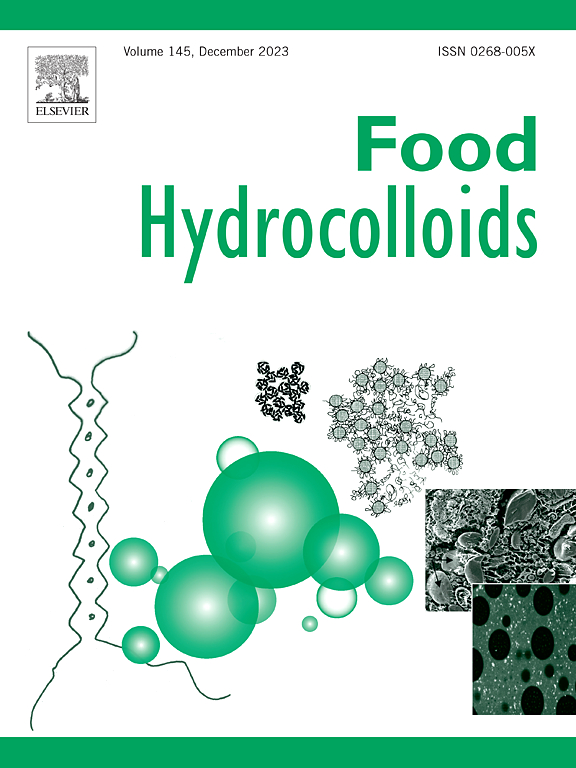Dynamic covalent network encapsulation of probiotics: A facile strategy for freeze-drying stability and controlled colon delivery
IF 11
1区 农林科学
Q1 CHEMISTRY, APPLIED
引用次数: 0
Abstract
Developing hydrogels capable of safeguarding probiotics against harsh upper gastrointestinal (GI) tract (stomach and small intestine) remains a pivotal challenge for effective colon delivery. Herein, we engineer imine cross-linked hydrogels by integrating oxidized konjac glucomannan (OKGM) into gelatin networks, creating mechanically robust and upper GI-tolerant carriers for probiotic protection. The dynamic covalent networks synergistically enhance mechanical robustness (elastic modulus: 5970 Pa, rupture stress: 13700 Pa) and tolerance to upper GI environments, alongside thermotolerance at 37 °C and self-healing properties. The hydrogel demonstrates minimal swelling in simulated gastric fluid (SGF) and programmed degradation in simulated small intestinal fluid (SIF), effectively shielding probiotics from acidic inactivation and enzymatic attack. With only 7.7 % OKGM, the system achieves 96 % encapsulation efficiency and sustains exceptional probiotic viability: 89 % survival post-SGF and 85 % post-SIF, outperforming conventional gelatin carriers. Notably, scanning electron microscopy (SEM) confirms that the hydrogel network preserves probiotic structural integrity even after freeze-drying—a critical advancement for industrial storage and scalability. The synergy between dynamic imine networks and OKGM/gelatine biopolymers ensures dual functionality: (1) buffering mechanical stresses during SGF and SIF transit, and (2) programmed degradation for colon-specific payload release. This work establishes a rational strategy to engineer gelatin-based hydrogels with spatially resolved GI resistance, addressing the core limitation of current oral delivery systems—premature probiotic inactivation in the upper GI tract. By enabling controlled colon delivery of viable probiotics, our findings advance the development of functional foods and therapeutic formulations requiring localized microbial activity.

益生菌的动态共价网络封装:一种冷冻干燥稳定性和控制结肠输送的简便策略
开发能够保护益生菌免受恶劣上胃肠道(胃和小肠)侵害的水凝胶仍然是有效结肠输送的关键挑战。在此,我们通过将氧化魔芋葡甘露聚糖(OKGM)整合到明胶网络中来设计亚胺交联水凝胶,创造出机械坚固且耐高gi的益生菌保护载体。动态共价网络协同增强了机械稳健性(弹性模量:5970 Pa,断裂应力:13700 Pa)和对上GI环境的耐受性,以及37°C的耐热性和自愈性能。该水凝胶在模拟胃液(SGF)中表现出最小的肿胀,在模拟小肠液(SIF)中表现出程序性降解,有效地保护益生菌免受酸性失活和酶的攻击。仅7.7%的OKGM,该系统实现96%的封装效率,并保持卓越的益生菌活力:sgf后存活率为89%,sif后存活率为85%,优于传统的明胶载体。值得注意的是,扫描电子显微镜(SEM)证实,即使在冷冻干燥后,水凝胶网络也能保持益生菌的结构完整性——这是工业储存和可扩展性的关键进步。动态亚胺网络和OKGM/明胶生物聚合物之间的协同作用确保了双重功能:(1)缓冲SGF和SIF运输过程中的机械应力;(2)结肠特异性有效载荷释放的程序化降解。本研究建立了一种合理的策略来设计具有空间分解胃肠道抗性的明胶基水凝胶,解决了当前口服给药系统的核心限制-上消化道益生菌过早失活。通过控制益生菌的结肠输送,我们的研究结果促进了功能性食品和需要局部微生物活性的治疗制剂的发展。
本文章由计算机程序翻译,如有差异,请以英文原文为准。
求助全文
约1分钟内获得全文
求助全文
来源期刊

Food Hydrocolloids
工程技术-食品科技
CiteScore
19.90
自引率
14.00%
发文量
871
审稿时长
37 days
期刊介绍:
Food Hydrocolloids publishes original and innovative research focused on the characterization, functional properties, and applications of hydrocolloid materials used in food products. These hydrocolloids, defined as polysaccharides and proteins of commercial importance, are added to control aspects such as texture, stability, rheology, and sensory properties. The research's primary emphasis should be on the hydrocolloids themselves, with thorough descriptions of their source, nature, and physicochemical characteristics. Manuscripts are expected to clearly outline specific aims and objectives, include a fundamental discussion of research findings at the molecular level, and address the significance of the results. Studies on hydrocolloids in complex formulations should concentrate on their overall properties and mechanisms of action, while simple formulation development studies may not be considered for publication.
The main areas of interest are:
-Chemical and physicochemical characterisation
Thermal properties including glass transitions and conformational changes-
Rheological properties including viscosity, viscoelastic properties and gelation behaviour-
The influence on organoleptic properties-
Interfacial properties including stabilisation of dispersions, emulsions and foams-
Film forming properties with application to edible films and active packaging-
Encapsulation and controlled release of active compounds-
The influence on health including their role as dietary fibre-
Manipulation of hydrocolloid structure and functionality through chemical, biochemical and physical processes-
New hydrocolloids and hydrocolloid sources of commercial potential.
The Journal also publishes Review articles that provide an overview of the latest developments in topics of specific interest to researchers in this field of activity.
 求助内容:
求助内容: 应助结果提醒方式:
应助结果提醒方式:


